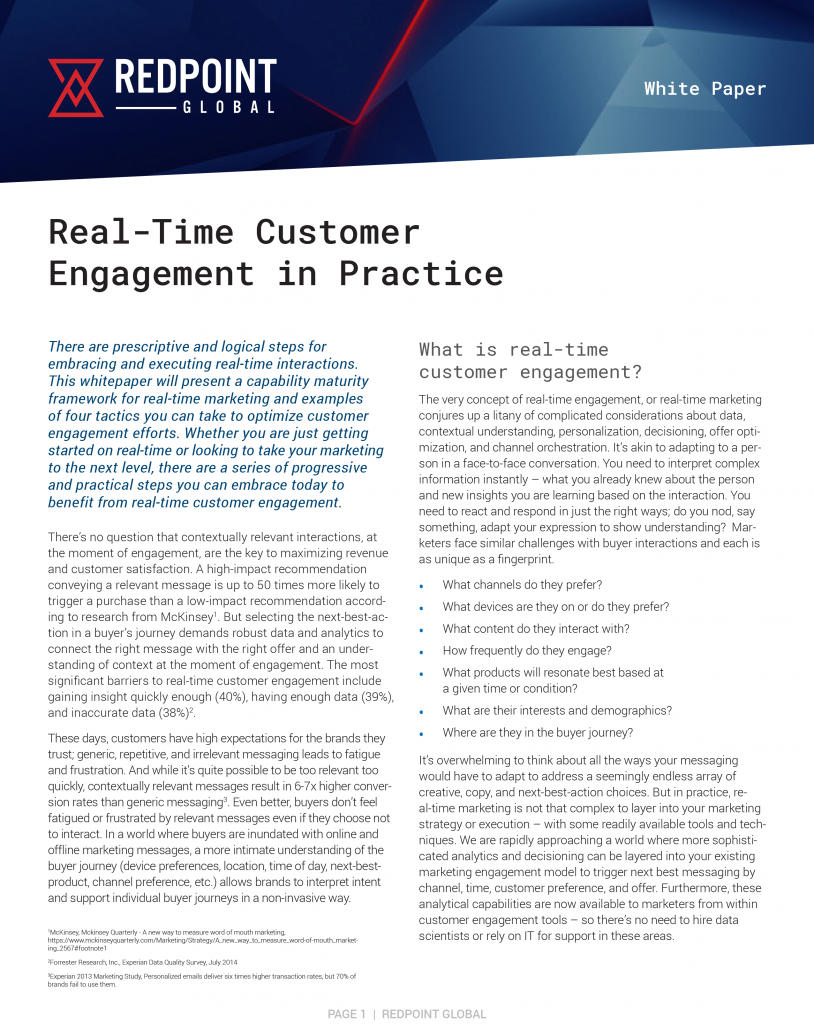 At first glance, there is a seeming disconnect between the rising volume of consumer data and the ability of marketers to use data to create a personalized customer experience. With the many signals about buying patterns, preferences, and transactions that consumers provide at every omnichannel touchpoint, it appears the consumer is handing marketers everything they need to create personalized engagements.
At first glance, there is a seeming disconnect between the rising volume of consumer data and the ability of marketers to use data to create a personalized customer experience. With the many signals about buying patterns, preferences, and transactions that consumers provide at every omnichannel touchpoint, it appears the consumer is handing marketers everything they need to create personalized engagements.
Yet the ever-increasing volume, variety, and velocity of data from the continuously connected consumer also has the potential to swamp customer engagement for the marketing organization unaware of the steps needed to effectively manage the data.
Data veracity, which reflects the accuracy and diversity of an organization’s consumer data, is the chart that ensures customer engagement isn’t dashed on the rocks of a poor customer experience with untrusted, unvetted data that is not representative of either the population you’re trying to serve or the questions you’re trying to answer. Veracity requires data quality – the traditional “garbage in, garbage out” problem still exists – as well as machine learning models that ensure data precision and accuracy. Data is certain and reliable only with a diverse data set that accurately reflects the audience at large.
Representative Data and Data Diversity
Achieving data veracity can be a challenge. Marketing organizations are so focused on stemming the tide of the consumer data wave that tasks such as data aggregation, cleansing, validation, matching, linking, and even analysis become overwhelming. According to research from ClickZ and Fospha, 37 percent of marketers say their company analyzes less than 20 percent of the consumer data that is available to them.
Ensuring data veracity can help increase the percentage, by giving marketers confidence – and trust – in the analysis. It starts with creating machine learning models that are free from bias and assumptions that undermine results. A recent facial recognition engine failure demonstrates the challenges marketers must overcome. An algorithm based on a data set that included a high percentage of white men was understandably far more likely to misidentify the gender of black women than it was white men. One widely used facial-recognition data set was estimated to be more than 75 percent male and 80 percent white.
The facial recognition example highlights the need for data sets to be representative. Without representation, personalized customer engagement becomes far more difficult because there is less context in the data set – information that a marketer may know about a wider, representative audience that helps bring relevance to a segment-of-one.
Data diversity is equally important. Just as poor representation skews results and affects downstream personalization efforts, so too does implicit bias if machine learning models are fed information that presupposes an assumption.
Suppose for instance you’re training an algorithm to discern the difference between images of cars and trucks. If every image of a truck is taken at night with the vehicle’s headlights and running lights on, the algorithm will “learn” that any vehicle with lights must be a truck. Implicit bias carries a risk for an untold number of marketing engagements. A credit scoring algorithm that lacks diversity may make inaccurate assumptions about a zip code, for example.
Bias is pernicious largely because we’re mostly unaware of how it can affect efforts to personalize the customer experience. The risk in not addressing bias is that marketers may believe the stories their biased data tells them, making the common mistake of thinking that data acquisition combined with machine learning is half the battle to becoming a successful data-driven marketing organization. In reality, organizations must fully close the loop by addressing issues such as data completeness, relevance, and cadence. Ensuring data veracity and data quality is an important start, but steps still must be taken to measure results that will ultimately provide confidence in a single view of the customer from which personalized engagements are generated.
Measure, Measure, Measure
Data profiling is one of the most important things a marketing organization can do to ensure that personalization ultimately stems from accurate, trustworthy customer data free from bias. If data veracity is the chart that prevents markets from being overwhelmed by consumer data, data profiling is the compass that allows marketers to navigate results.
Data profiling explores measures based on audiences and goals, using visualization and analysis as aids in understanding something about the data itself rather than just something about the consumer. For example, a profiling solution could discover through analysis a high percentage of blank fields from a specific data source, or a large percentage of errors in a data set. Profiling results in quick wins for marketers, keeping marketers on the right path to personalized engagement by helping to ensure data quality and veracity baseline.
Measurement is another important step to strip bias from data sets. Measurement entails, first and foremost, the instrumentation of interactions – the collection of every available piece of information pertaining to a specific interaction; the unique customer, the offer, the promotion, the response – and measuring all of these data points in relation to one another to understand what is happening at each unique touchpoint.
Results themselves must also be measured – how did a customer respond to a program, an offer, or a next-best recommendation? Was the response positive or negative? Through A/B testing, marketers can measure campaign effectiveness against a base level to determine lift, which will shed light on whether a campaign’s rule sets are working and determine whether data veracity is at a satisfactory level.
Close the Data Loop with Customer Feedback
Marketers must also keep in mind of course that there is an actual customer at the end of every personalized engagement. In the context of the customer, measurement refers to understanding how a model works in the context of how it expects a customer to behave versus the customer’s actual behavior. Measurement requires gaining certain permissions from a customer and respecting the customer’s choices and expectations across touchpoints. Transparency from marketers about how they’re using customer data fuels customer trust, which in turn leads to more data being shared and even greater data accuracy.
A recent Harris Poll survey commissioned by Redpoint Global that explored this value exchange revealed that 54 percent of consumers are willing to share personal data with companies to achieve a more personalized customer experience, but 41 percent are still not satisfied with brands’ ability to tell the consumer how their information is being used.
Measuring the effectiveness of customer engagement rests on trust in data. Ensuring data quality, accurate representation, and diversity give marketers the confidence to measure the right things and answer the right business questions posed by consumer data. Are they using the right approach for a particular class of customers, for example?
Trust in data ensures trust in the accuracy of any category of measurement, closing the data loop for marketers and yielding confidence that personalized engagements are continually optimized. Putting consumer data through its paces is essential for marketers to harness the insights in the data to deliver personalized engagements that will ultimately win, serve, and retain customers.
RELATED ARTICLES
Why Data Quality Matters for IT and Business Stakeholders
How Does Data Governance Differ from Data Quality?
4 Steps to More Efficient Data Preparation

